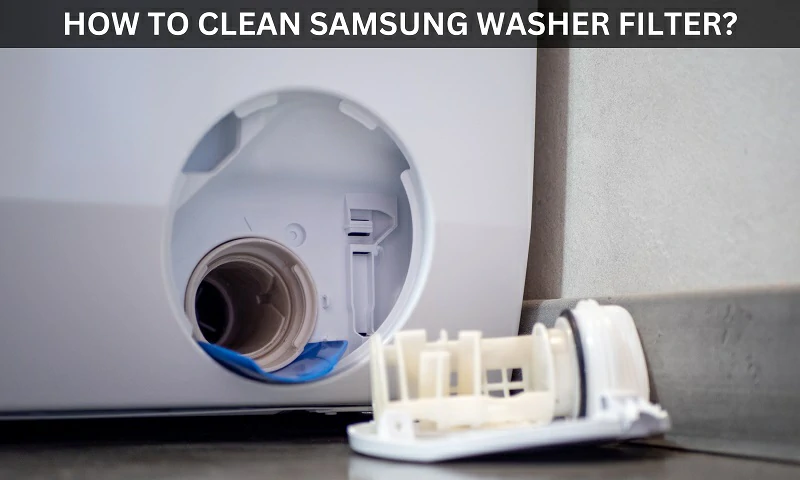A washing machine is a wet appliance. Water, detergent, and other laundry chemicals are continuously flushed inside the washer tub, making it moist. When this moisture gets trapped inside the washing machine, it becomes a suitable place for microbes to thrive.
Due to this microbial action, mildew can be formed, making the washing machine smell bad. In this article, we will look at the possible reasons for your washing machine to smell bad and discover tips to eliminate the bad odor.

Why Does My GE Washer Smell Bad?
Your GE washer might smell bad due to the following reasons:
- Mildew Formation inside the Washer Tub
- Soap scum residue build-up inside the seals and gaskets
- Limescale formation
- Sewage gases rising through the drain pipe
Mildew Formation Inside the Washer Tub
The washer tub is a moist place. Moisture can easily trap inside the tub after a wash cycle. Also, if you seal the door air-tight soon after a wash cycle, the moisture gets trapped inside and becomes a suitable place for mildew growth. Since no air or sunlight gets inside the washer tub, mildew spreads faster and produces a bad odor.
How to Identify Mildew Formation in Your Washer?
- Using a flashlight, look into the tub for any mildew formation. The mildew will be found as dark black spots on the surface of the tub. You can also experience musty smell from the inside of the tub.
- Sometimes when you wash your clothes, you can find the mildew to be stuck on your cloth fibers. This is also a sign of mildew build-up in the tub
Getting rid of Mildew in Tub
Your GE washer model might have a self-clean cycle which can get rid of the mildew easily. Follow these steps to remove the mildew from your GE top-load or front load washer:
- Mix 1/4 cup of water and 1/4 cup of baking soda in a container
- Pour this mixture into the detergent dispenser of your washer. If you don’t have a dispenser, pour the mixture directly into the tub.
- Then take 2 cups of white vinegar and pour it directly into the wash tub
- Instead of this mixture, you can also use washing machine cleaner solution available in the store
- Close the door and initiate the self-clean wash cycle in your machine
- This cycle will use hot water to flush the entire machine including the dispenser tray
- This will remove the mildew present in the machine
- After the wash cycle, open the door or lid of your washer and let it air out. This will avoid trapping the moisture and prevents mildew build-up
Soap Scum Residue Inside Gaskets and Seals
In front load washers, there is a good chance for the detergent residues, softener residues, and soap scum to get trapped in between the door seal. This residue can accumulate over a long period and causes bad odor in the washing machine. Since the gasket and seal is compact the soap can get into the gaps easily and may not be washed away without proper maintenance.
How to Identify Soap Scum in Door Seals?
- Open the door of the washing machine and look into the door seal
- You can find a lot of white sticky scum in the crevices of the gasket or seal. This indicates a heavy residue buildup in the machine.
- You can also find this residue to be stuck on your laundry. If you find white residue in your clothes, then there is a heavy soap scum present in the machine.
Removing the Soap Scum in Gasket and Seal
- You can run a self-clean wash cycle as mentioned previously to remove the soap scum in the washer. But it may not remove the residue stuck in the crevices of the door seal.
- To remove the residue buildup in the door seal, prepare a mixture of 1/4 cup water and 1/4 cup baking soda
- Remove the door seal from the front load washer. You can find the procedure to remove door seal from this lid lock replacement guide.
- Then, Take an old toothbrush, dip it in the mixture and scrub the residue present in the door seal. Also, scrub the area where the seal sits in the door.
- After wiping with the mixture, put few drops of bleach in a bowl of water and wipe the seal thoroughly using this bleach solution
- Now, take some white vinegar and wipe the seal and the door thoroughly. Leave the door open till the door and door seal is dry completely.
This will remove the odor and soap scum from the seals completely. Also, you can prevent mold or mildew formation in the wash tub.
Limescale Formation
Scale formation can cause bad odor in your washing machine and can reduce your machine’s efficiency. The scales can buildup mainly due to the use of hard water for washing the clothes. Hard water has a lot of salts dissolved in it and when reacting with the detergent it can sediment on the drum, water line, and other intricate parts of the washer causing an unpleasant odor.
How to Identify Scale Formation in Washer?
Scale formation may or may not be apparent in the washing machine. You can sometimes find hard translucent pieces of scales present in the water inlet hose. If the buildup is too much, you can even here noises in the washing machine.
Getting Rid of Scales in Washer
- You can descale your washing machine using a descaling solution or powder that is available commercially
- Add this descaler solution to the detergent tray and initiate a self-clean cycle
- The descaler can react with the hard sedimented limescale salts and wash it
- You can use this descaling technique once every month to reduce the amount of scale buildup in the washer
Sewage Gases Rising Through the Drain Pipe
If you find your washer to smell like rotten eggs, then there is something wrong with your washer’s drainage system. Your GE washing machine may not be draining and causing the sewer gases to rise up to the washing machine’s drain line. Because of this your washing machine is too smelly.
How to Identify Sewer Gases Rising Through the Drain Pipe?
When you open the washer door and find it to be stinky or giving out rotten egg smell, then you can assure that there is an issue with the drainage of the washer.
How to Get Rid Of Rotten Egg Smell in Your Washing Machine?
- To remove the rotten egg smell in your washing machine, check the drain pipe for any clogs
- If the drain pipe is not properly leveled, the wastewater may not flow into the standpipe properly
- Check whether there are any clogs in the standpipe
- Remove any stagnant water in the drain pipe and standpipe to get rid of the gases
- If the standpipe doesn’t have a P-trap, try to install a P-trap to prevent sewer gases from rising
How to Prevent Washer from Foul Smell?
With proper maintenance of the washer, you can prevent the production of foul odor. Here are the tips you can follow to prevent bad smells:
- Keep the door or lid open after completing wash cycles to air out the washer. This prevents the development of mold and mildew inside the appliance.
- Clean the washer tub and door seals periodically to prevent residue buildup
- Keep the softener dispenser and other trays clean to prevent scum buildup
- If you are using hard water, avoid using too much of hot wash cycles. Because, using hot water in hard water can create more limescales
- Run a self-clean cycle periodically using the baking soda and vinegar mixture to wash the scum and residue
- Make sure to check the drainage of the washer periodically to help prevent sewer gases rising to the drain pipe


